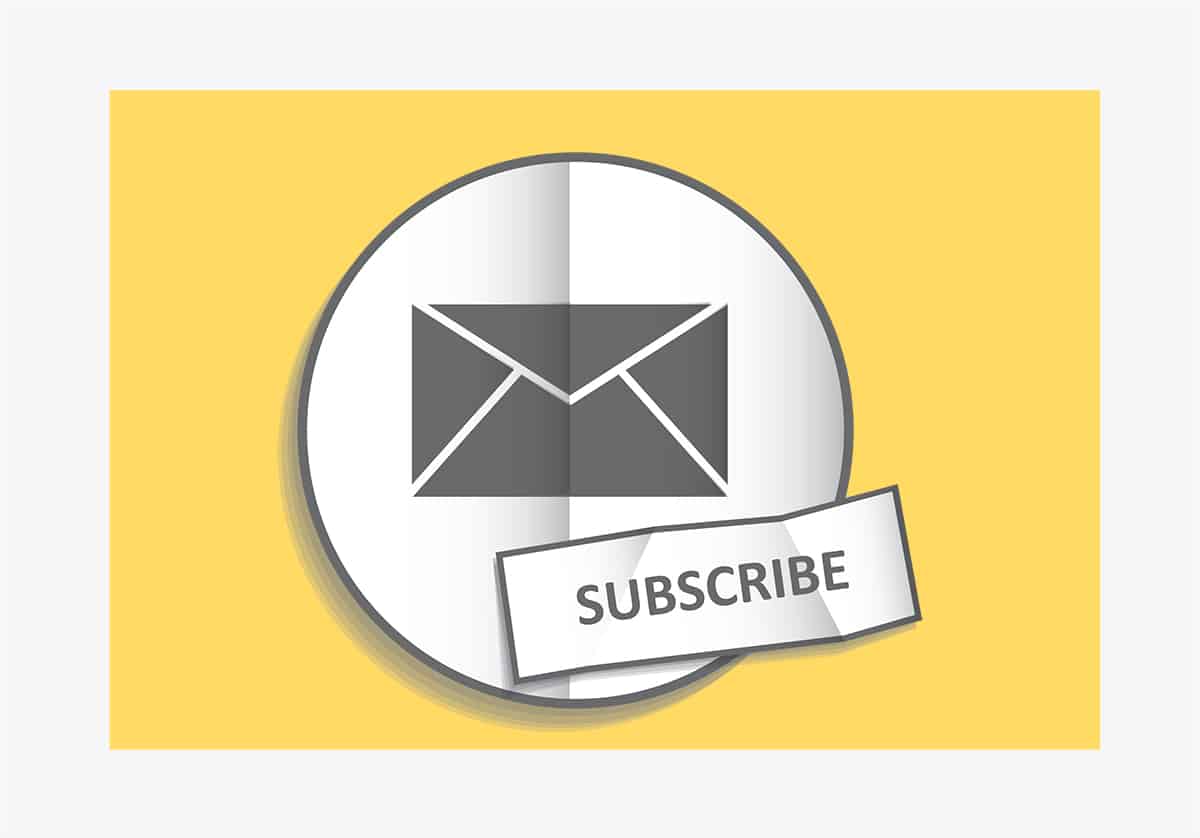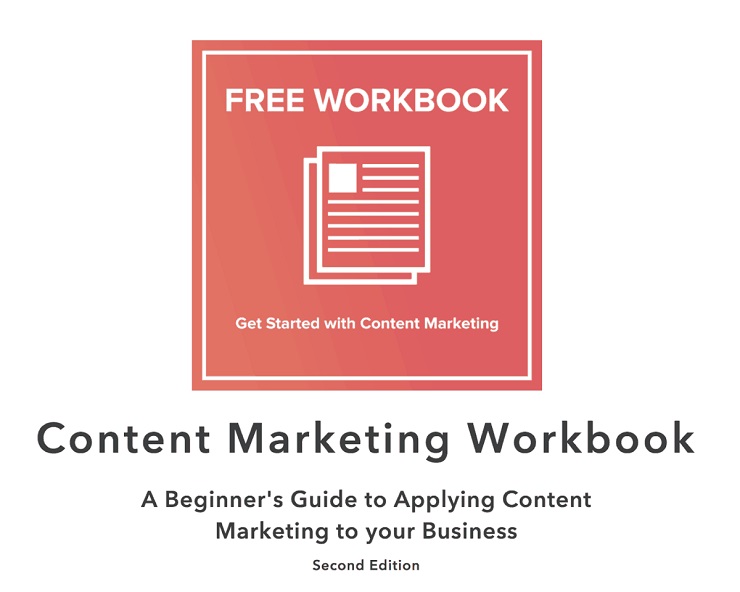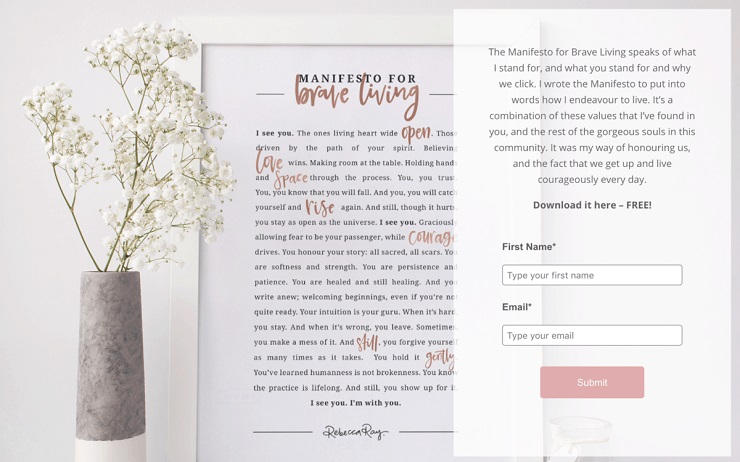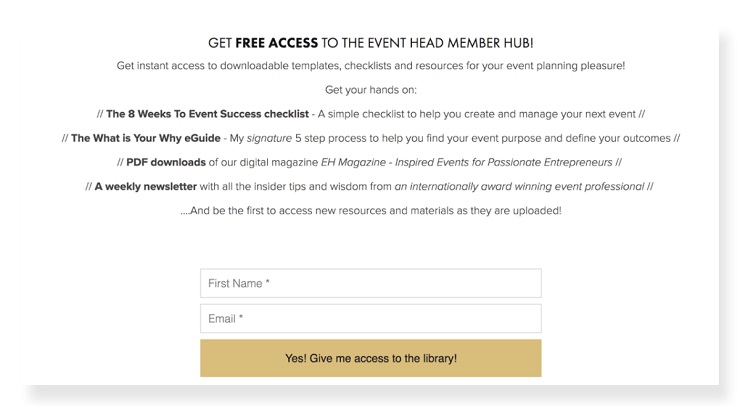So you’re gearing up to grow your email list. Let me be the first to tell you that a dialog box labeled “Subscribe!” isn’t going to cut it. In this competitive landscape, your potential subscribers demand a bigger, better opt-in offer. Something they can’t resist, that will blow them away once it arrives. Here are some tips and ideas to make it happen.
There’s a good chance you’re familiar with opt-in offers already, but let’s briefly review. Also called a “lead magnet” or “lead offer,” an opt-in offer is an incentive that you provide in exchange for a subscriber’s email address. It’s often promoted through your other free content, such as blog posts or your website.
Free content leads people to your opt-in offer, which gathers up email addresses of potential leads, which gets them into your sales funnel, which gets people to buy something. Easy peasy. Sort of.
Your opt-in offer can be any sort of content, such as a newsletter or ebook. But with more people chasing after email addresses, it’s gotta be something good.
There’s also a wide variety of incentives you can use, but not every type is suitable for every industry or audience. Below, we’ll dive in and discuss some different types, along with the pros and cons of each.
Characteristics of Effective Opt-In Offers
Consumers aren’t naïve. They know how valuable their information is, and what you plan to do with it, and they’re not willing to give it to just anyone. They’re also drowned in a digital world full of promises and bribes, which is, if you think about it, exactly what an opt-in offer is.
You give me this, and I’ll give you that.
This approach is not wrong, necessarily, nor is it uncommon. Marketers worldwide use bribes in the form of opt-ins to build out their email lists and grow their audiences. Because of this, yours is likely only one of 10, 20, or 50 opt-in offers that an average consumer faces in one day.
Modern consumers find themselves constantly fighting to protect their inboxes and their time from businesses hungry to gain precious new leads. Nowadays, the process of unsubscribing from vapid newsletters and spammy discount emails can take as much time as subscribing did in the first place.
To break through your audience’s ever-sharpening defenses against junk mail and empty promises, you must offer a genuinely valuable and appealing piece of information. In fact, your opt-in offer should be so valuable that your audience might consider paying for it, if they couldn’t get it by trading their email addresses instead.
An effective opt-in offer must:
Offer a Targeted Solution
Your opt-in offer doesn’t have to solve all of your audience’s problems.
As a marketer, it’s tempting to want to offer a wide range of solutions in order to cast a wide net. While that aspiration is admirable, an opt-in offer isn’t the place to exercise it. Just as we’ve encouraged in target audience research, narrow is better. Being too broad can negatively impact your business and exhaust your resources and team.
Take Bonafide, a marketing agency, for example. They offer a (super) wide variety of services, but their Rebranding Checklist focuses on one precise pain point: How the heck can I start the rebranding process? This helps their customers stay focused and reach a single targeted solution, making it a much more powerful offer.
Be Consistent With Your Overall Message or Product Offering
The purchase (or download) path on which consumers travel is a fragile one. Bombarded with constant noise and distraction, it’s easy to change direction with a simple click. For a moment, remove your marketer hat and put on your consumer one. When browsing the web, how often do you jump around websites, pages, and posts? How many tabs do you have open right now? Don’t think that your audience doesn’t behave the same way.
It’s this fragility that makes consistency so important. Your opt-in offer must match your overall message and offering, especially that of the content you used to pitch your opt-in offer.
For example, Foundr currently offers a free MasterClass session on growing your Instagram followers to upwards of 10,000. They promote this offer through their blog, but only recommend it within content that’s relevant to the offer, such as posts on curating a gorgeous feed, Instagram influencer marketing, and marketing tips from Instagram experts.
Can you imagine if this specific opt-in offer appeared within a post on starting podcasts or dealing with stress? Since it would require a deviation from the topic at hand, a reader would likely skip right over it, failing to read more or provide an email address.
Consistency is the key to meeting expectations, and expectations are what send readers right to the Download button.
Provide Value Not Otherwise Offered on Your Website or Blog
While your opt-in offer must remain consistent with your overall message, it doesn’t have to mirror it. If your audience can go elsewhere on your website or blog to access the information within your opt-in (without providing valuable personal information), why would they download it?
For an opt-in offer to be valuable enough to warrant sharing information, it must not be accessible elsewhere on your site. Your opt-in offer must dive deeper and provide bigger, better information. It can’t simply be a blog post disguised as a well-designed pdf; it must be more distinctive.
Perhaps “distinctive” for your business is a sample of your services, a free course, or a weekly newsletter containing premium information. The type of opt-in offer you create depends on a variety of factors, but the hallmark of each one should be exclusivity and value.
For example, Ryan Robinson is a thought leader in the freelance writing space. He shares his freelance writing proposal—not otherwise available on his website—in exchange for some reader information. This alone creates the perception of scarce, special content, making it more likely to be downloaded in exchange for an email.
Let’s dive into some top opt-in ideas and decide which might be best for you.
ATTENTION: Do you want to learn how to explode your email list from the ground up and get your first 10,000+ subscribers? We are launching a new list-building course taught by Stuart McKeown, co-founder of Gleam.io. Click below to get more info on the course and sign up for the FREE VIP waitlist to get notified when we launch.
Join Our FREE List-Building Course VIP Waitlist!
6 Enticing Opt-In Offer Ideas
1. Newsletter
Ah, the classic promise to subscribers—a recurring newsletter full of updates, offers, and “members-only” information. This is a solid opt-in offer, especially if you’re already in the business of churning out content.
But if you’re not, beware. Newsletters require a lot of fresh material and variety. Plus, your newsletter is likely one of many that your audience sees in a week.
On the bright side, an email newsletter is one of the easiest offers to craft and maintain. All you need is an email marketing platform like MailChimp or Drip, and time (which, funny enough, can be the most expensive resource).
This is yet another area where catering to a specific niche can help your newsletter’s success. The Love Assembly, for example, is a travel, style, and life inspiration blog dedicated to inspiring and motivating young women to live more creative and curious lives. In their newsletter, The Love Assembly offers exclusive travel information, inspiring content, and information about giveaways and travel opportunity. By focusing on a specific niche, The Love Assembly is able to provide valuable, unique information to their audience.
Don’t create a newsletter just to create one, however. The purpose of a newsletter is to offer your subscribers high-value advice, tips, and resources to help them succeed. If you can’t provide this on an ongoing basis, think about a different content opt-in offer. It’s even worse to start a newsletter campaign before you’re able to send newsletters, because when you do, your subscribers will have forgotten they subscribed and potentially mark your company as a spammer, which will affect your email-sending reputation.
2. Ebook
An ebook is most marketers’ go-to for opt-in offers. On the surface, ebooks promise exclusive, concentrated content that can be downloaded and kept for the long term. This promise of ownership alone is enough to motivate some people to opt-in.
Thankfully, ebooks don’t have to be hundreds of pages long to be useful. In this case, quality matters much more than length. An information-packed ebook could be anywhere between five and 10 pages long and still provide greater value than a blog post.
Ebooks do require extra time and resources outside of a traditional editorial calendar. Once you’ve decided what topic to delve into, assign one or two writers and editors to craft the content. Ebooks should also contain much more than just words. Consider hiring a graphic designer to make your information easy to navigate and digest. Here’s a comprehensive resource on how to create a high-converting ebook for every budget.
Marketing software company HubSpot offers a wide variety of ebooks, guides, and content-related offers on their website. One of their most popular offers is their Content Marketing Workbook, available to anyone who completes their form.
HubSpot is an international authority on marketing, especially content and inbound marketing methods, so this offer extends that knowledge for the (small) price of personal information. If you choose to tackle an ebook as your content offer, be sure you stick with topics related to your overall knowledge and services.
3. One-Pager
There are many terms to describe this type of content: tip sheet, blueprint, cheat sheet, checklist, worksheet, or template. The goal with this opt-in offer is to make each subscriber’s life even easier by doing some of the work for them.
A cheat sheet or checklist is also an excellent display of your skills and services, which is why it’s useful for most businesses and industries. Whether you’re a business blogger or online mattress store, there’s almost always a process or practice you can illustrate with a worksheet.
For the business blogger, it might be a small business marketing plan template. For the mattress store, it might be a checklist of things to consider when buying a new mattress. The possibilities here are endless. And you can also create them pretty quickly and inexpensively.
One popular opt-in example along these lines is a manifesto, which acts as a type of inspiration for your readers. It’s also a persuasive way to establish your purpose as a blogger, coach, or business. Dr. Rebecca Ray offers her own Manifesto for Brave Living as a free download for her clients, readers, and website visitors.
Regardless of what type of one-pager you want to offer, it’s relatively easy to make. All you need is a word processor like Microsoft Word or even Google Docs. Simply create your one-pager, design, and brand it, and save it as a PDF to share.
4. Case Studies
Case studies are a phenomenal way to showcase your expertise within your niche and help you craft a narrative about your customers’ successes. Case studies can be great opt-in offers if you enjoy storytelling as a means of marketing. A great way to think about case studies is placing real life examples behind all those bullet points about your products and services on your website.
Case studies are also fantastic incentives, because they create a sense of community among an audience and show readers that there are others just like them. Readers typically like when you keep things real, especially when faced with a specific problem or hurdle, and case studies are a great way to do just that.
When writing a case study, start by deciding who your subject will be. They could be within your organization, a client or customer, or a similar business in your industry. Next, build out your interview and start chatting with them. Also, be sure to ask for permission (always!) to feature them, preferably as your very first question.
In your interview, ask questions that help you get to know them and their problems, solutions, challenges, and results. If you’re telling a story about your own customer, what did they appreciate about your product or service? If you’re talking with another company that you admire, what about their story stands out as interesting and innovative? Your case study should bring to light new information not otherwise available on your website or blog.
AMP Marketing Agency created a case study about how they helped Patagonia connect with and market to their customers – through a road trip. The study explained AMP’s influence on Patagonia, but it also displayed the agency’s ability to flesh out, analyze, and reflect on strategy and data, which displayed their vast marketing knowledge.
As the cherry on top, AMP finished their case study with a sweet call-to-action: “Find out how we can put solutions like these to work for you.” As a brand new visitor to AMP’s blog, this content offer and CTA would certainly bring me back for more.
5. Courses
Offering a free course as an opt-in incentive is yet another way to spread your knowledge and demonstrate your expertise. The best part about this type of opt-in offer is that it can be offered in practically any medium—text, video, slideshow, and more. And once you’ve created it, the course can be repurposed and shared for months or years (depending on its relevance).
Nowadays, it’s easier than ever to access educational resources, but it’s still rare to be able to learn from those we trust and respect. Depending on your connection with your audience, offering a free course based on your own story is sure to catch the attention of your subscribers.
For example, Daria Zest of Signature Life Coaching offers a free video course on how she changed her life and income. No, the information in this course isn’t tailored to each individual viewer (you’d have to sign up for that), but it still provides unique, exclusive content unavailable elsewhere.
6. Member-Only Forums or Communities
We all want to belong, don’t we? Especially to something exclusive and catered to our industry or interests. That’s why offering access to a members-only community can be such an effective opt-in incentive. You provide a place where like-minded people can gather and benefit from shared knowledge on a targeted subject, and subscribers provide their personal information for access.
This community can manifest itself in a variety of ways. Perhaps you provide access to an exclusive Facebook group or Slack channel in exchange for an email address. Or, like Event Head Event Management group, you simply provide access to a hub of material and the promise for more.
Exclusivity can be created in a number of ways. If your business targets a niche audience, a members-only community can be an excellent way to drum up email addresses. And besides attracting new subscribers, this method can help you gather content and feedback from your own audience. You might need to establish communication guidelines and moderate discussion, but besides that, your community can operate on its own.
ATTENTION: Do you want to learn how to explode your email list from the ground up and get your first 10,000+ subscribers? We are launching a new list-building course taught by Stuart McKeown, co-founder of Gleam.io. Click below to get more info on the course and sign up for the FREE VIP waitlist to get notified when we launch.
Join Our FREE List-Building Course VIP Waitlist!
Create Opt-In Offers Readers Can’t Resist
There are so, so many types of opt-ins you can use to grow your email list—. These are just a few of our favorites that have been successfully employed by Foundr, and some of Foundr’s own readers and customers.
Regardless of what type of incentive you offer in exchange for an opt-in, remember this: The goal is to make an offer your audience can’t refuse. Make an offer so good that your audience might consider paying for it.
Keep your opt-in offers relevant, targeted, and consistent, and you’ll watch your email list surge with new subscribers.
What sorts of opt-in offers have you used, or come across as consumers? Which ones have worked best? Let us know in the comments below!
























